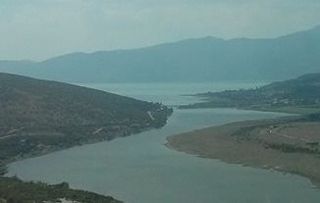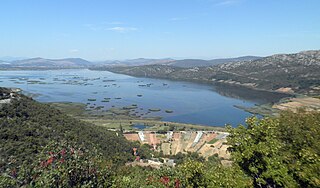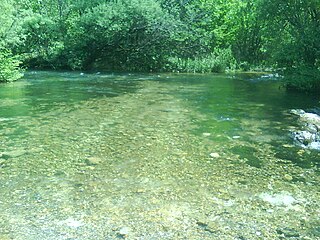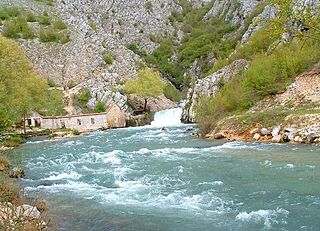
The Neretva, also known as Narenta, is one of the largest rivers of the eastern part of the Adriatic basin. Four hydroelectric power plants with large dams provide flood protection, electicity and water storage. The Neretva is recognized for its natural environment and diverse landscapes.

Livno is a city and the administrative center of Canton 10 of the Federation of Bosnia and Herzegovina, an entity of Bosnia and Herzegovina. It is situated on the river Bistrica in the southeastern edge of the Livno Field at the foot of Kruzi plateau which are located beneath the Cincar mountain and rocky hill Crvenice. Livno is the centre of the Canton 10 which mainly covers an area of the historical and geographical region of Tropolje. As of 2013, it has a population of 37,487 inhabitants. The town, with its historic ruins and old town from the 9th century, was first mentioned in 892, developing at the crossroads between the Adriatic coast and inland, i.e., regions of Bosnia, Dalmatia, Herzegovina, and Krajina.

Kamešnica is a mountain in the Dinaric Alps, located in the southern end of the Dinara Mountain Range on the border between Bosnia and Herzegovina and Croatia (Dalmatia). It is 1,851 metres (6,073 ft) high and stretches from the northwest white road pass Vaganj (1,173 m) to the Buško Blato artificial lake. The tallest peak is Konj (Horse) 1,855 metres (6,086 ft), which is located in Bosnia and Herzegovina and offers views of both sides of the border. In clear weather, it is possible to see the most remote areas of the Adriatic Sea and its islands. The vicinity's many trails and caves make it popular with hikers.

Buško Lake, also known as Buško Blato or Buško Jezero is an accumulation lake located near the Croatian border on the south side of Livanjsko Polje and northwest of Duvanjsko Polje in Canton 10, a canton of the Federation of Bosnia and Herzegovina, one of the two entities of Bosnia and Herzegovina. The name is also a reference to the area surrounding the lake which includes a number of villages, of which Prisoje is the largest.

Livanjsko polje, located in Bosnia and Herzegovina, is the largest polje in the world and a RAMSAR wetland site. A typical example of karst polje encircled by tall peaks and mountain ranges, the field is characterized by many unique natural phenomenons and karstic features.
The Trebišnjica is a river in Bosnia and Herzegovina, and the right tributary of the Neretva. Before it was utilized for hydro exploitation via various hydrotechnical interventions and systems with different purposes, Trebišnjica used to be a sinking river, rising and sinking through its course before resurfacing at various places from the Neretva river below the Čapljina to the Adriatic coast, and along the coast from the Neretva Delta to Sutorina.

The Čapljina Pumped-Storage Hydroelectric Power Plant is a pumped-storage hydroelectric power plant (PSHPP) or pumped hydroelectric energy storage power plant (PHESPP) type of hydroelectric power plant, whose powerhouse is situated underground near Svitava, in Bosnia and Herzegovina. It's one of country's largest hydroelectric power plants of any type, having an installed electric capacity of 420 MW.

Lištica is a sinking river in Bosnia and Herzegovina. It starts under the name Ugrovača, and end its course as the Jasenica in Mostarsko Polje, before spills into the Neretva as its right-bank tributary. It is listed as the second coldest river in Europe, and is prone to constant flooding mostly during winter. The Lištica river connects with the Borak wellspring, which rises at the base of the mountainside on the outskirts of town of Široki Brijeg. The town of Široki Brijeg was named Lištica after the Lištica River during the SFR Yugoslavia (1945–1990) but changed its name when the country dissolved back into Bosnia and Herzegovina.
Ćavarov Stan is a village in the Municipality of Tomislavgrad in Canton 10 of the Federation of Bosnia and Herzegovina, an entity of Bosnia and Herzegovina.

Ruda is a small river in the Dalmatian Zagora region of Croatia. It is a left tributary of the Cetina river, into which it flows about 1 km north of Trilj. The Orlovac Hydroelectric Power Plant, located partly in the Split-Dalmatia County and partly in Bosnia and Herzegovina, discharges the water used to generates power into the Ruda river.

The Rama is a river in Bosnia and Herzegovina, and a major tributary of the Neretva. It joins it from the right by discharging into Neretva's artificial reservoir, Jablaničko lake, at place called Marina Pećina, near village of Gračac, between location of underground powerhouse of Rama Hydroelectric Power Station and Jablanica Dam, depending on water level in Jablaničko lake, some 15 kilometers upstream from Jablanica.

Bistrica is sinking river near Livno in Western Bosnia, Bosnia and Herzegovina, though highly regulated for hydropower and irrigation since mid-20th century.

Žabljak is a river near Livno in Western Bosnia, Bosnia and Herzegovina. It flows for roughly 6.6 kilometers westward through Livanjsko Polje before its confluence with the Bistrica, just upstream from beginning of its section with artificially created riverbed, from where river begins to turn southward toward Buško Blato.
The fish fauna of the Neretva river basin in the western Balkans is representative of the Dinaric karst region and characterized by several endemic and endangered species.

The Šuica which is known as the Šujica (Шујица), is a sinking river flowing through Duvanjsko Polje and the wider region of Tropolje in Bosnia and Herzegovina. The river also runs through its subterranean section, which begins at the point where river goes underground within the main estavelle (ponor) at Kovači. This section of the Šuica is traversable for trained speleologists with proper equipment.

The Zalomka is a karstic river in the southern part of Bosnia and Herzegovina, and as part of the Neretva river system it is one of the largest sinking rivers in the country and Dinarides. It rises under the Morine plateau, near Brajićevići village in Gacko municipality, but also collects its upper course waters from Gatačko Polje.

Lake Vrutak is artificial reservoir on the Trebišnjica river in Popovo Polje, near Hutovo village, Bosnia and Herzegovina. The lake serves as compensation and storage basin for Pump-Storage Hydroelectric Power Plant "Čapljina".
Jasenica is a sinking river in Bosnia and Herzegovina. It begins as the Ugrovača river, runs through canyon where it gets new name, the Brina, and flows into the town of Široki Brijeg. Here it connects with the Borak wellspring that rises at the base of the mountainside near Široki Brijeg, thus creating the Lištica river.















